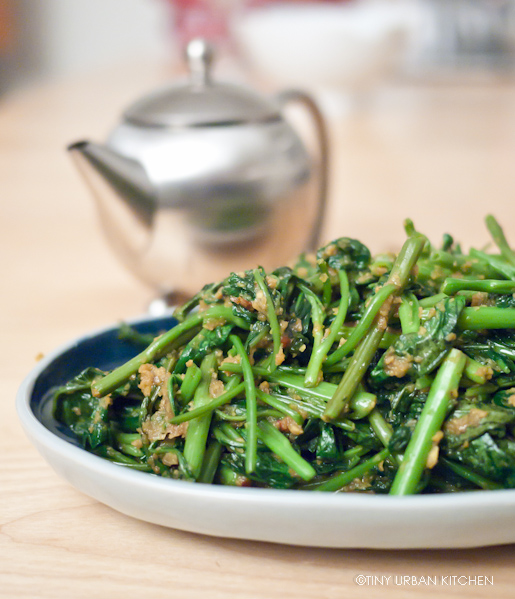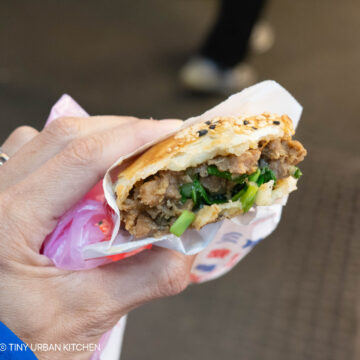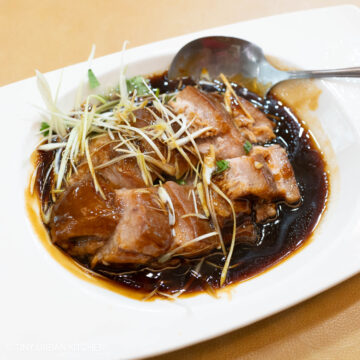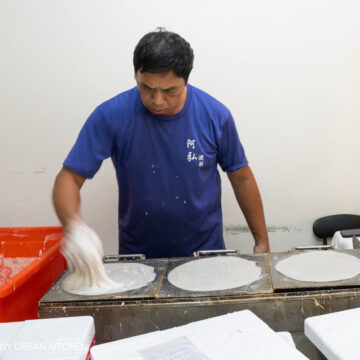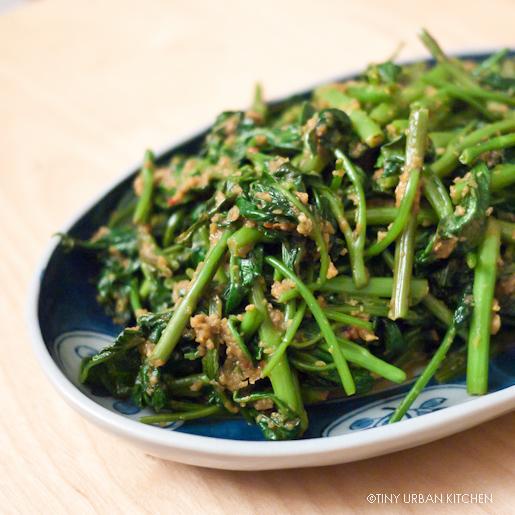
Welcome to Day 2 of our three part Malaysian Food Series! If you missed Day 1, Hainanese Chicken Rice, you can check it out here.
If you are Asian, you're bound to have heard of water spinach, or hollow heart vegetable (空心菜). Even though I don't know Southeast Asian food well, I instantly recognized this vegetable because we also eat it in Chinese cooking. In fact, the water spinach is so prolific in Asia, it does not even need soil to grow, profusely thriving in marshy wetlands, rivers, and streams. In parts of the US, it has become so prolific that the USDA has official designated it a "noxious weed." It grows THAT easily.
Malaysia's version of this dish is called kangkung belacan. It is served all over Malaysia, from casual food courts to upscale hotel restaurants. Traditionally, this is a peasant preparation of the dish, though it has gotten trendy in recent years.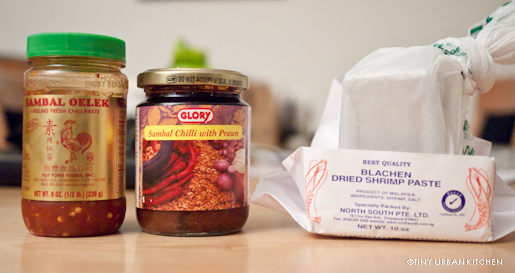
Let me tell you, if you are unfamiliar with Malaysian ingredients, it might be a bit frustrating the first time you go grocery shopping in a Chinese market. To be honest, I don't know how easy it is to get all these ingredients. I stumbled around Boston's Chinatown for quite some time, only to turn up relatively empty-handed. I was able to find Sambal Oelek (left) in the Chili Section, but it was hard finding everything else.
In fact, the belacan (dried shrimp paste pictured on the right) is from a store in Southern California. I have no idea where to get it in Boston. I seriously think it may just be less intimidating to buy all your ingredients online. At least you can just search for your term and order it! 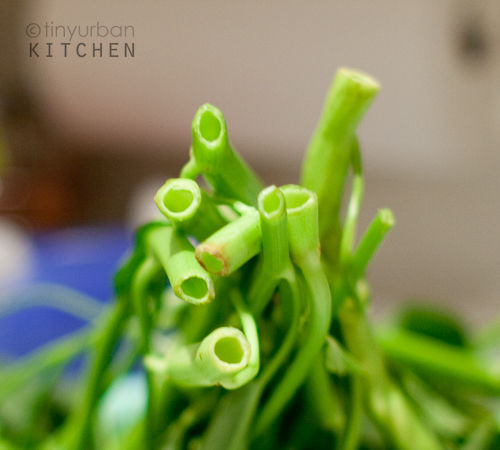
Finding the ingredients was really the hardest part of this dish. Once you have everything, you just make a sauce by blending together aromatics, spices, and shrimp paste. Saute your vegetables with the sauce, add a few spices, and voila, that's it!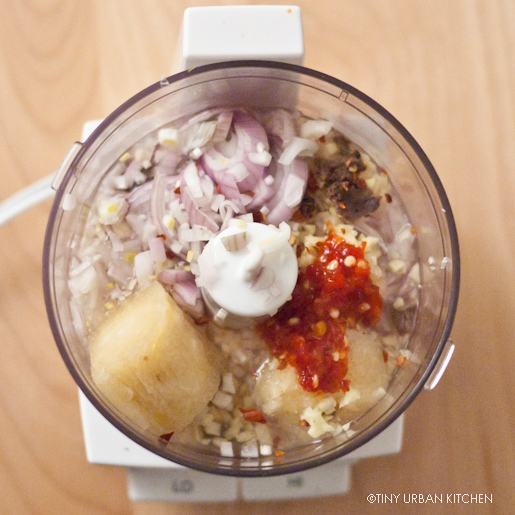
The belacan definitely adds a deep and flavorful umami to the entire dish that's really different from the Chinese version. Just a word of caution about belacan - this stuff is really really potent! It's got a really strong smell - definitely vent the place and maybe even open some windows especially if you plan on toasting it. Your toaster oven will smell like belacan for a while afterwards. We opened the windows even though it was below freezing outside!
The smell of the belacan lingered in our tiny little apartment for days.
Neverthless, the dish itself is still delicious and quite authentic. Our table of diners polished the whole dish off in no time.
Giveaway!
This Malaysian series was inspired by a free review copy I got of Flavors of Malaysia by Susheela Raghavan. You can read a more detailed account of my thoughts regarding the book here. The publisher has been kind enough to provide me with THREE books to give away! I will be giving one away per day during this series - one for each dish I cook from the book!
The first Giveaway is still going on: Click here if you want to enter that one as well.
For this giveaway, comment below and tell me your favorite Southeast Asian restaurant! If you don't know any Southeast Asian restaurants, just name your favorite Asian restaurant.
For me, I woefully have very little exposure to Malaysian food. In fact, I think the only restaurant I've tried is Penang (in both Harvard Square, Boston Chinatown, and New York City!). In all three cases I thought the food was delicious!
Giveaway ends Thursday, March 3, 2011 at midnight! I reserve the right to pick another winner if I pick the same winner twice during this three-part giveaway series.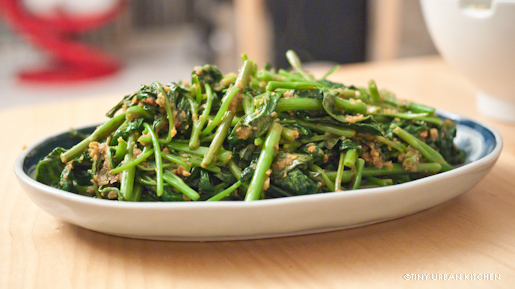
Spicy Water Spinach
from Flavors of Malaysia: A Journey Through Time, Tastes, and Traditions
Ingredients
2-3 T cooking oil
¼ teaspoon ground coriander
⅛ teaspoon turmeric powder or ½ teaspoon chopped fresh or frozen turmeric root (¼ inch to ½ inch piece)
1 teaspoon regular soy sauce
1 T tamarind concentrate or tamarind juice extracted from pulp
1 small bunch (about 6-8 stalks with leaves, 8 ounces) water spinach, bottom stems trimmed about 1 to 2 inches and washed in water, swirling a few times to remove and dislodge dirt and sand
Optional: ¼ teaspoon salt
Spice Paste
¼ cup sliced shallots or onions
1 heaping tablespoon sliced garlic cloves
½ teaspoon sliced ginger or galangal
1 to 3 fresh red chilies (cayenne, Fresno, jalapeno, Serrano, Thai, or cherry), sliced
½ teaspoon dried shrimp paste (balacan) toasted at 400 °F for 15 minutes or 1 heaping teaspoon of dried whole shrimp, soaked in hot water for 10 min to soften and then drained
¼ cup water
1. Process Spice Paste ingredients to a coarse paste
2. Heat 1 T oil in a wok or skillet and saute Spice Paste for about 5-6 minutes, till fragrant, adding 1 to 2 more T oil if needed. Add ground coriander and turmeric and stir for another ½ to 1 minute.
3. Add soy sauce and tamarind juice and stir for about 1 minute.
4. Add water spinach and stir for about 4 minutes, turning the leaves over often and coating well with sauce, till leaves wilt and become bright green with stems still retaining their crispiness. Add salt if needed.
Serve!
Disclaimer
Time to time I receive free products, meals, etc. as a food blogger. I do not receive any payment for blog posts/reviews nor am I required to write a post when I receive free products, meals, etc. The views expressed in this post are completely my own. I was given a free review copy of the book.
All Rights Reserved













